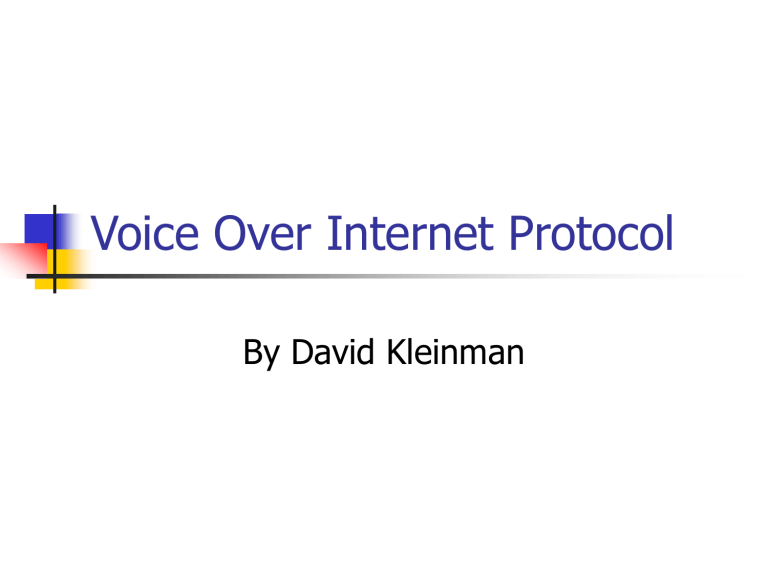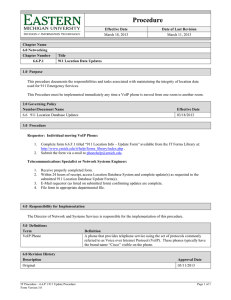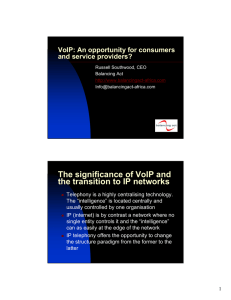semKlein
advertisement

Voice Over Internet Protocol By David Kleinman Outline Define VoIP Protocols Advantages / Disadvantages Current Research What is it? VoIP allows you to make telephone calls using a computer network, over a data network like the Internet. VoIP converts the voice signal from your telephone into a digital signal that travels over the internet then converts it back at the other end so you can speak to anyone with a regular phone number. When placing a VoIP call using a phone with an adapter, you'll hear a dial tone and dial just as you always have. VoIP may also allow you to make a call directly from a computer using a conventional telephone or a microphone. Also referred to as IP Telephony Voice conversations are turned into digitized data and packetized for transmission across a network. Picture IP address to Phone Number VoIP look for IP address The central call processor is a piece of hardware running a specialized database/mapping program called a soft switch. Soft switches know: Translate Phone numbers to IP addresses Where the endpoint is on the network What phone number is associated with that endpoint The current IP address assigned to that endpoint If soft switch does not have the information, the request is handled by another soft switch. Protocols Used to connect different pieces of hardware. H.323 SIP Most widely used protocol provides specifications for real-time, interactive videoconferencing, data sharing and audio applications (VoIP) More streamlined protocol Developed specifically for VoIP Lack of a standard protocol is a problem. Not always compatible. VoIP VS PSTN PSTN = Public Switched Telephone Network VoIP uses Packet Switching which is more efficient than a dedicated line Also compression can be used Can transmit data (video) Advantages Cost Free VoIP to VoIP Low cost VoIP to Public Switch Telephone Network (PSTN) Less bandwidth requirements Low cost / no cost software and hardware Mobility Any internet connection Growing number of wireless broadband locations Drawbacks Quality Dependent on wall power Lost or delayed packets cause drop-out in voice Emergency Calls High quality PSTN Variable VoIP dependent on connection Hard to find geographic location Security Most VoIP services do not support encryption Analysis of On-Off Patterns in VoIP and Their Effect on Voice Traffic Aggregation Wenyu Jian and Henning Schulzrinne Studied human speech which consists of talkspurts and silence gaps (on-off paterns) Benefits of silence suppression Department of Computer Science at Columbia University Allow higher bandwidth utilization Echo suppression Found that spurt distributions is slightly more “heavy-tailed” than exponential Assessment of VoIp Quality over Internet Backbones Athina P. Markopoulou, Fouad A. Tobagi, Mansour J. Karam Assess quality of VoIp Cosidered Delay and loss Voice quality Playback buffer schemes Results Many paths performed poorly for VoIP traffic due to long delays and large delay variability Playback buffer schemes – tradeoff between data loss and increased delay in the buffer Overall rated VoIP as poor Mark voice traffic and give it preferential treatment Choose playback buffer scheme to match delay pattern




